Discover 15 hidden attractions, cool sights, and unusual things to do in L'Aquila (Italy). Don't miss out on these must-see attractions: Basilica of San Bernardino, Stadio Tommaso Fattori, and Santa Maria di Collemaggio. Also, be sure to include Campo Imperatore in your itinerary.
Below, you can find the list of the most amazing places you should visit in L'Aquila (Abruzzo).
Table of Contents
Basilica of San Bernardino
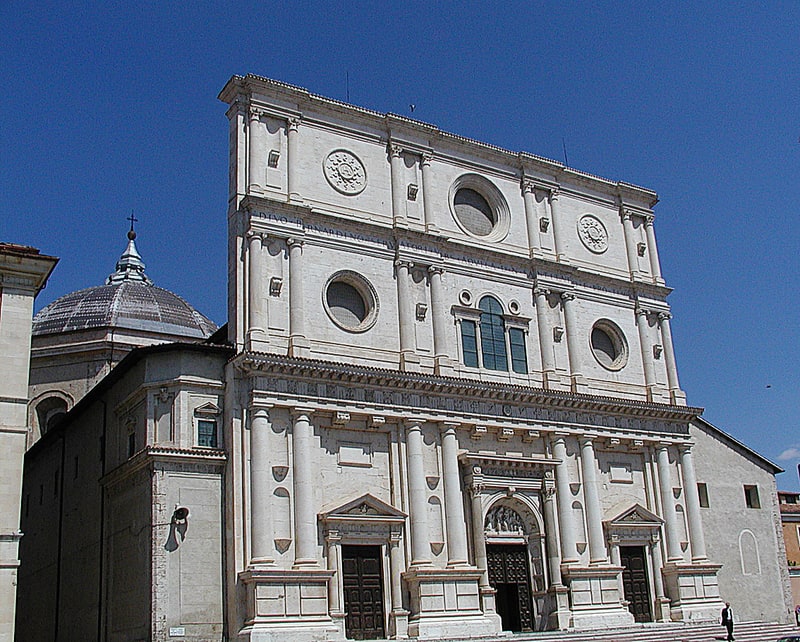
Also known as: Basilica di San Bernardino
Catholic church in L'Aquila, Italy. The Basilica of San Bernardino is located in L'Aquila, Italy. The church was built, with the adjacent cloister, between 1454 and 1472 in honor of St Bernardino of Siena. The corpse of the saint is guarded inside the church in a mausoleum and it was declared a Basilica Minor in May 1946 by Pope Pius XII.
The earthquake in April 2009 seriously ruined the apse and the campanile. In May 2015, the basilica was reopened to the community.[1]
Address: Via San Bernardino, 67100 L'Aquila
Stadio Tommaso Fattori
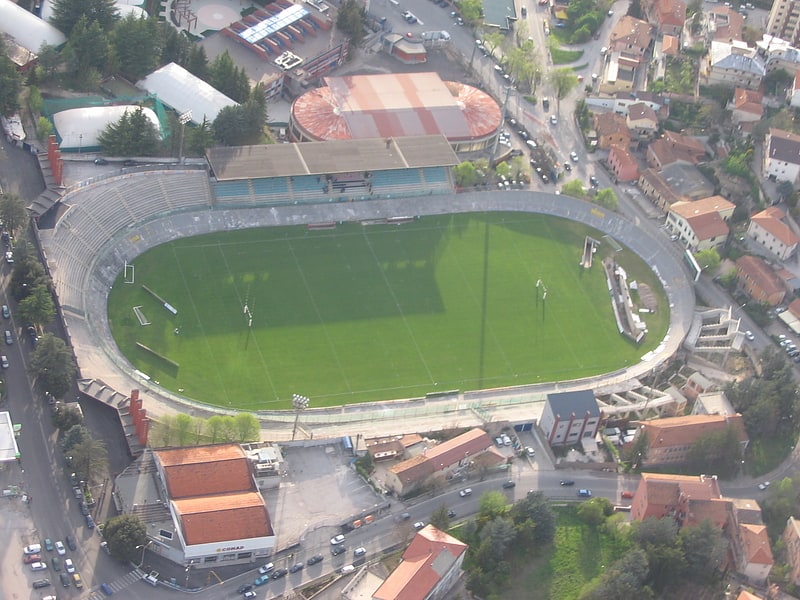
Stadium in L'Aquila, Italy. Stadio Tommaso Fattori is a multi-use stadium in L'Aquila, Italy. It is currently used mostly for football and rugby union matches and the home of L'Aquila Calcio and L'Aquila Rugby. Inaugurated in 1933, the stadium holds 10,000 people.
It hosted some of the football preliminaries for the 1960 Summer Olympics.[2]
Address: Viale Gran Sasso, 67100 L'Aquila
Santa Maria di Collemaggio

Basilica in Italy. Santa Maria di Collemaggio is a large medieval church in L'Aquila, central Italy. It was the site of the original Papal Jubilee, a penitential observation devised by Pope Celestine V, who is buried there. The church, which therefore ranks as a basilica because of its importance in religious history, sits in isolation at the end of a long rectangular sward of grass at the southwest edge of the town.
The church is a masterpiece of Abruzzese Romanesque and Gothic architecture and one of the chief sights of L'Aquila. The striking jewel-box effect of the exterior is due to a pattern of blocks of alternating pink and white stone; the interior, on the other hand, is massive and austere. Outbuildings include a colonnaded cloister, with the central fountain typical of many other similar Italian cloisters, and the former monastic refectory.
Parts of the structure were significantly damaged in the 2009 earthquake in L'Aquila and the church was reopened in 2017.[3]
Campo Imperatore
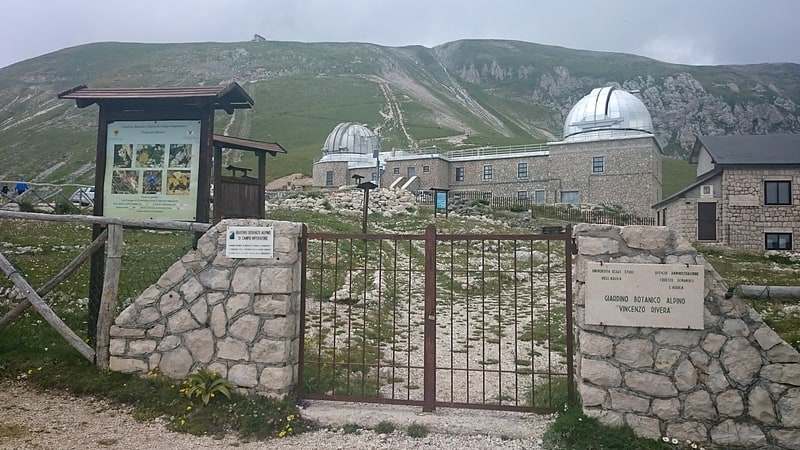
Botanical garden in Italy. The Alpine Botanical Garden of Campo Imperatore is a botanical garden for alpine plants located at Campo Imperatore, L'Aquila, Abruzzo, Italy. It is operated by the University of L'Aquila.
The garden was founded in 1952 by botanist Vincenzo Rivera. It collects plants local to the nearby Gran Sasso massif of the Apennine Mountains, including hundreds of grass species, false bilberry, greater gentian, and the Apennine edelweiss.[4]
Address: Gran Sasso d'Italia, 67100 L'Aquila
Forte Spagnolo
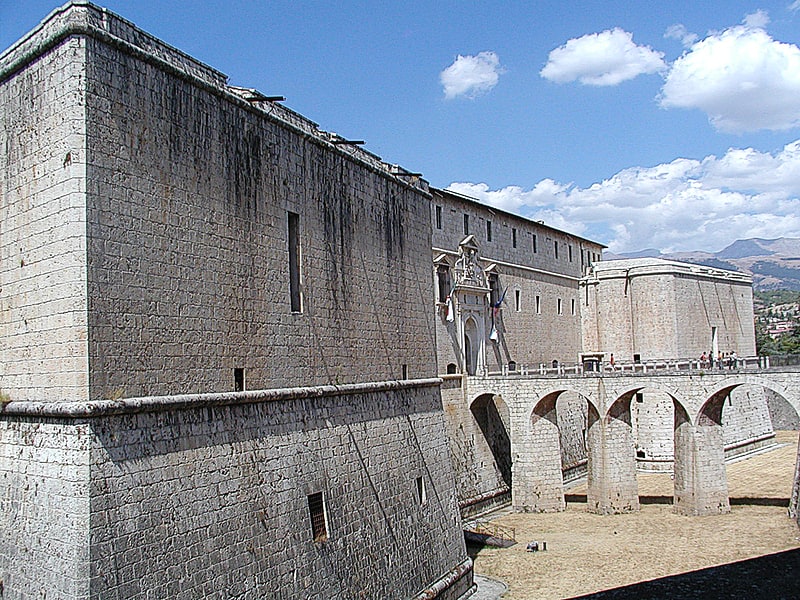
Also known as: Forte spagnolo
Castle in L'Aquila, Italy. The Forte Spagnolo is a Renaissance castle in L'Aquila, central Italy.[5]
Address: Via Benedetto Croce, 67100 L'Aquila
L'Aquila Cathedral

Also known as: Duomo dell'Aquila
Cathedral in L'Aquila, Italy. L'Aquila Cathedral is a Roman Catholic cathedral in L'Aquila, Abruzzo, Italy, dedicated to Saint Maximus of Aveia and Saint George. It is the episcopal seat of the Archdiocese of L'Aquila.[6]
Address: Via Roio, 67100 L'Aquila
Piazza del Duomo
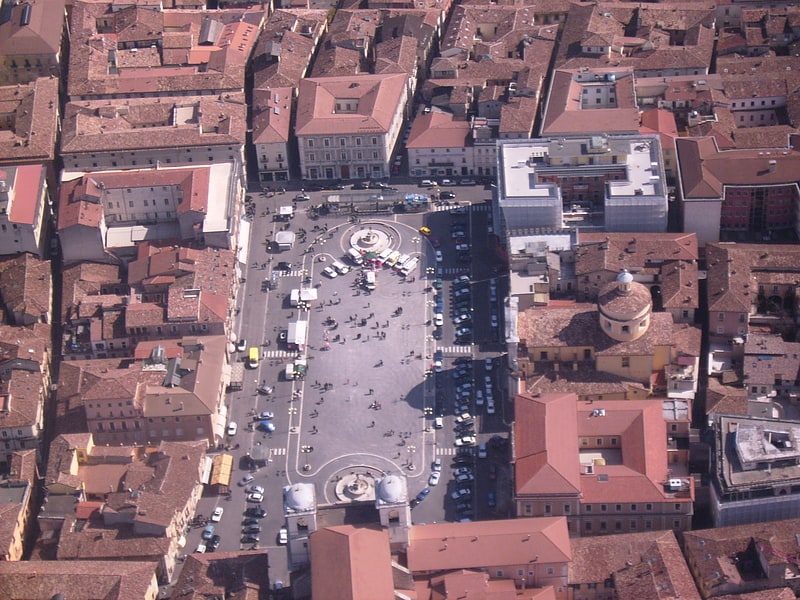
Souvenir store in L'Aquila, Italy. Piazza del Duomo is a city square in L'Aquila, Italy.[7]
Address: Centro Storico off-limits, 67100 L'Aquila
Santa Giusta

Church in L'Aquila, Italy. Chiesa di Santa Giusta is a Romanesque church in L'Aquila.[8]
Santa Maria del Suffragio

Catholic church in L'Aquila, Italy. Santa Maria del Suffragio, commonly called the church of Anima Sante, is an 18th-century church in L'Aquila, central Italy.
It was begun on October 10, 1713, ten years after the 1703 L'Aquila earthquake damaged the Confraternita del Suffragio's former seat.
The Roman architect Carlo Buratti was charged with the work. In 1770 Gianfrancesco Leomporri added a Baroque façade, and years later, in 1805, the church was completed with a neoclassical dome by Giuseppe Valadier.
Being one of the most important churches of the city, Santa Maria del Suffragio also became one of the main symbols of the 2009 L'Aquila earthquake when, on April 6, 2009, it suffered serious damages and its dome was almost entirely pulled down by the quake.
The extensive damage to the church was a direct consequence of a lack of retrofitting. Although The church received a great deal of funding to be architecturally restored and aesthetically 'upholstered' but lacked investment into the protection of its structural integrity; which is a disappointment as it was believed by many to be a building of cultural and architectural significance.[9]
Address: Piazza Duomo, 43, 67100 L'Aquila
Santi Marciano e Nicandro
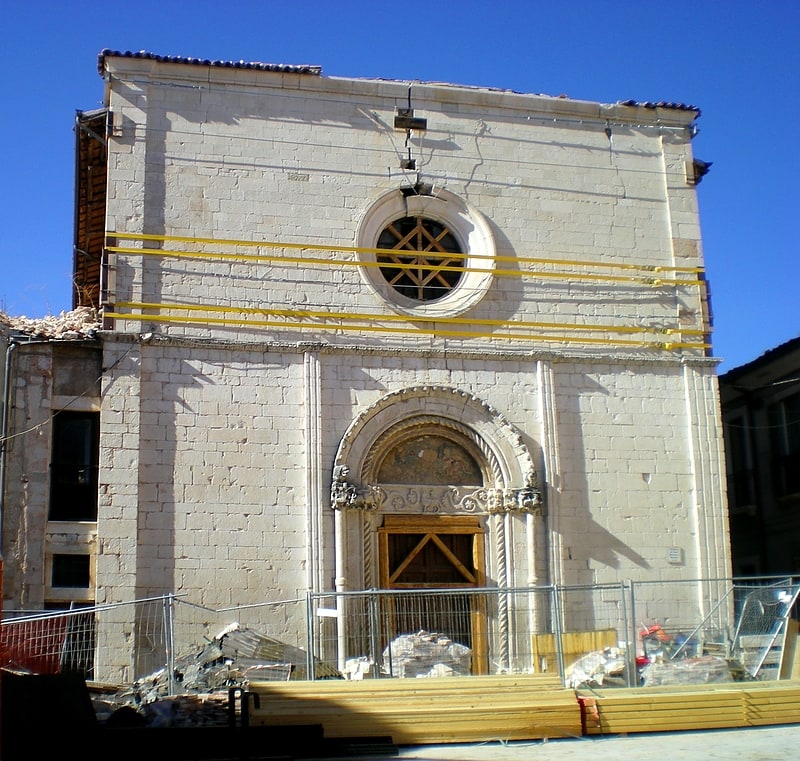
Catholic church in L'Aquila, Italy. Chiesa dei Santi Marciano e Nicandro is a church in L'Aquila, central Italy.
It was built in Romanesque style in the course of the 13th century, and, after it had been mostly destroyed by an earthquake in 1703, it was renovated in Baroque style. The church was again severely damaged by the earthquake which struck L'Aquila in 2009.
The façade in white stone dates from the 14th century. The portal has capitals with the Four Evangelists (left) and the Adoration of the Magi (right), and is surmounted by a circular window which in 1915 replaced the original rose window. The interior dates mostly from the 18th-century renovation, although the original 13th-century structure has survived in the apse exterior, in the presbytery and the clergy house. It houses 14th- and 15th-century frescoes and statues of St. Peter and St. Marcian.[10]
Address: Via Santa Chiara D'Aquili, 67100 L'Aquila
Palazzetto dei Nobili
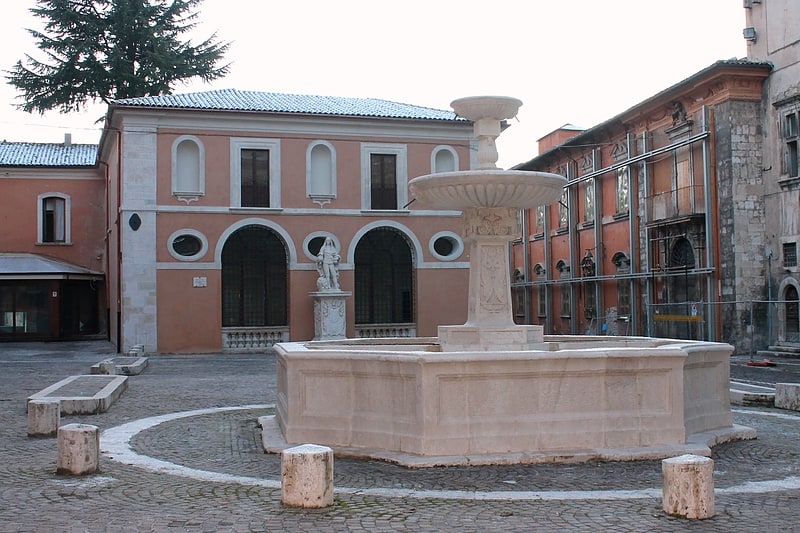
The Palazzo della Congregazione dei Nobili, better known as Palazzetto dei Nobili or “Oratorio dei Nobili”, is a historic building of L'Aquila in Southern Italy.
The Palace is located in L’Aquila center at piazza Santa Margherita, 2.[11]
San Silvestro

Catholic church in L'Aquila, Italy. San Silvestro is a Gothic-style, Roman Catholic, former church in the town of L'Aquila, in the region of Abruzzo, Italy. The church is presently under restoration after the 2009 earthquake.[12]
Address: Piazza San Silvestro, SN, 67100 L'Aquila
Santa Giusta
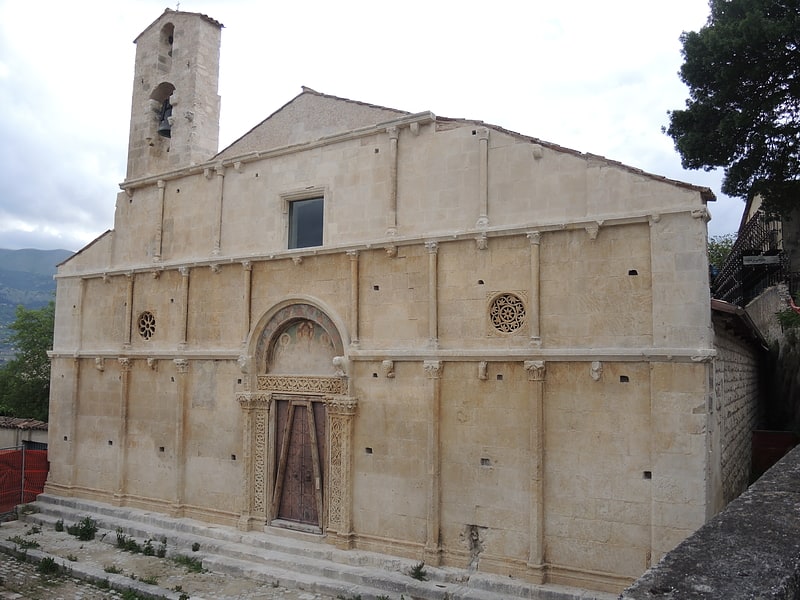
Catholic church in Bazzano, Italy. Chiesa di Santa Giusta a Bazzano is a Romanesque church in Bazzano, frazione of L'Aquila.[13]
Museo Nazionale d'Abruzzo
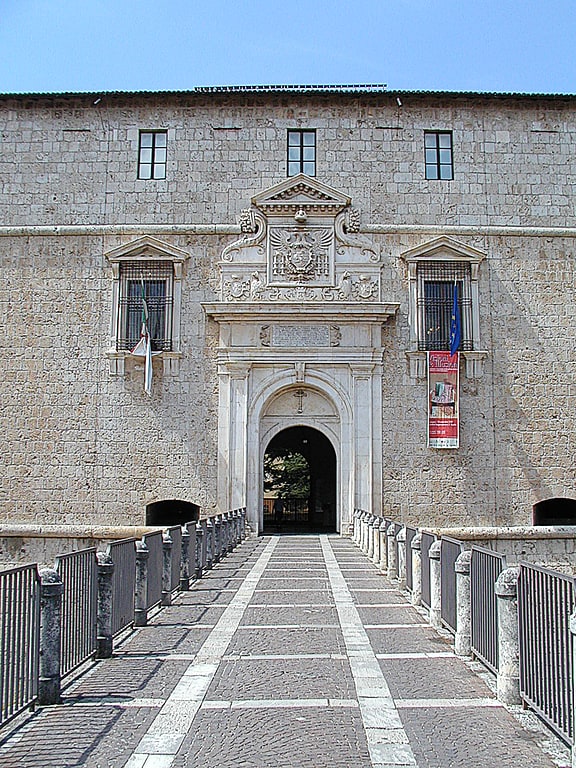
Also known as: Museo nazionale d'Abruzzo
Museum in L'Aquila, Italy. The Museo Nazionale d'Abruzzo is hosted in the Forte Spagnolo of L'Aquila.
The Museum is on three floors: on the ground floor, there is the giant skeleton of an Archidiskon meridionalis (improperly called mammoth, a prehistoric "elephant") found a few miles from Aquila in 1954, and an archeological section with pieces of the Italic pre-Roman period, a section with inscriptions and pieces from the Roman towns in Abruzzo, among them a fine Roman calendar from Amiternum (25 AD).
On the first floor the medieval and modern art section, with works of Abruzzese artists of the centuries 13-17th such as: the polyptych by Jacobello del Fiore; a Processional Cross by Nicola da Guardiagrele, a group of wooden and terracotta sculptures such as a St Sebastian by Silvestro dell'Aquila and another by Saturnino Gatti; paintings by Flemish and Roman and Neapolitan artists such as Sebastiano Conca, Giulio Cesare Bedeschini, Francesco Solimena, Francesco de Mura; finally the contemporary art section with such artists as M. Vaccari, Renato Guttuso, Virgilio Guidi, Giuseppe Capogrossi, Orfeo Tamburi, and Remo Brindisi.[14]
Orto Botanico dell'Università dell'Aquila

Also known as: Orto botanico dell'Università dell'Aquila
Historical place in Italy. The Orto Botanico dell'Università dell'Aquila, also known as the Orto Botanico di Collemaggio, is a botanical garden in L'Aquila, Abruzzo, central Italy, operated by the University of L'Aquila. Measuring 5.5 hectares, it is located near the basilica di Collemaggio.
The garden contains about 460 species, including many indigenous to Abruzzo such as Adonis flammea subsp. cortiana, Anchusa hybrida, Campanula cavolinii, Cerastium scarani, Dianthus ciliatus, and Linaria purpurea.[15]